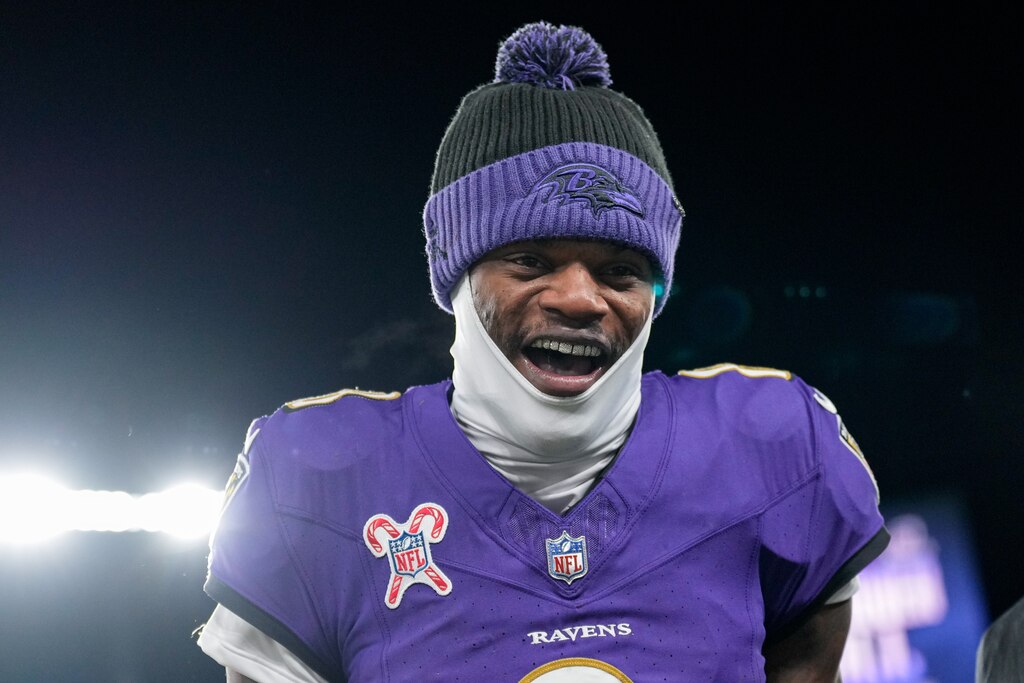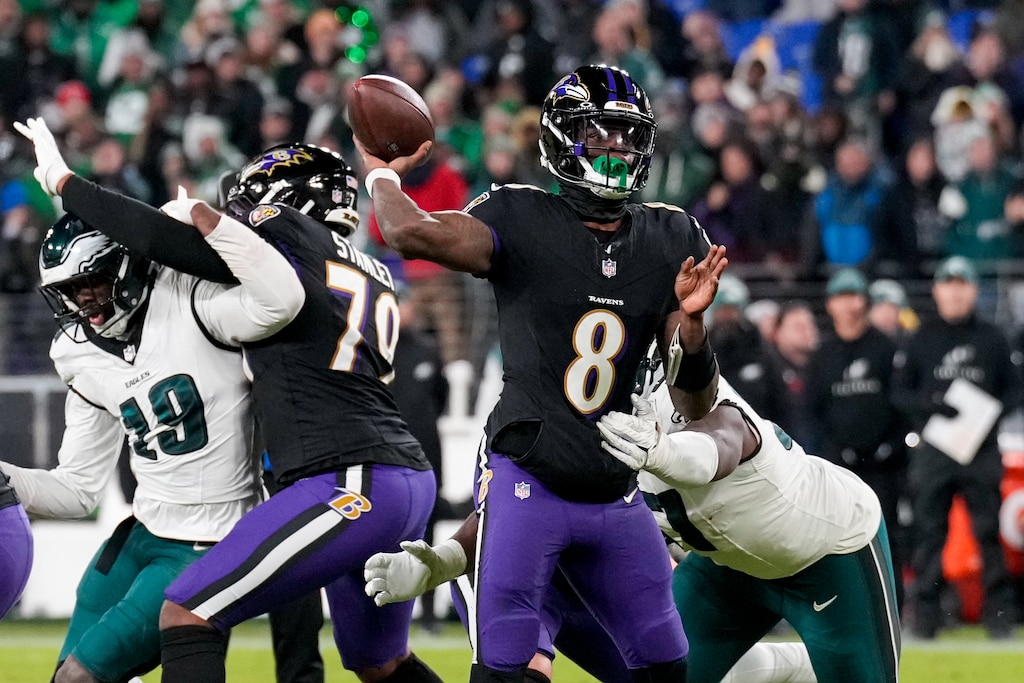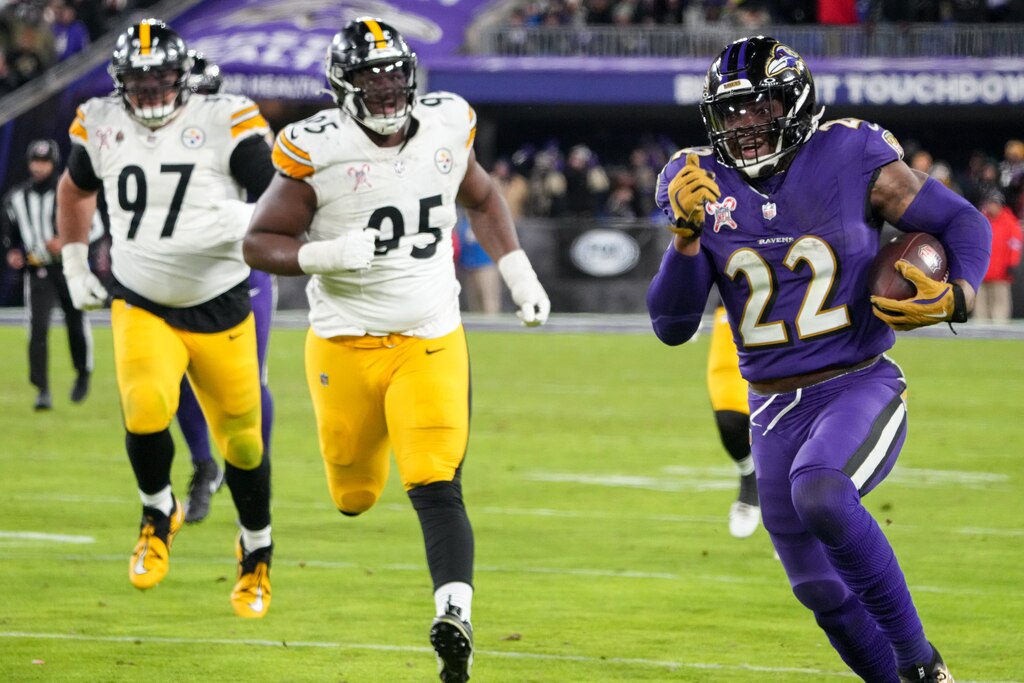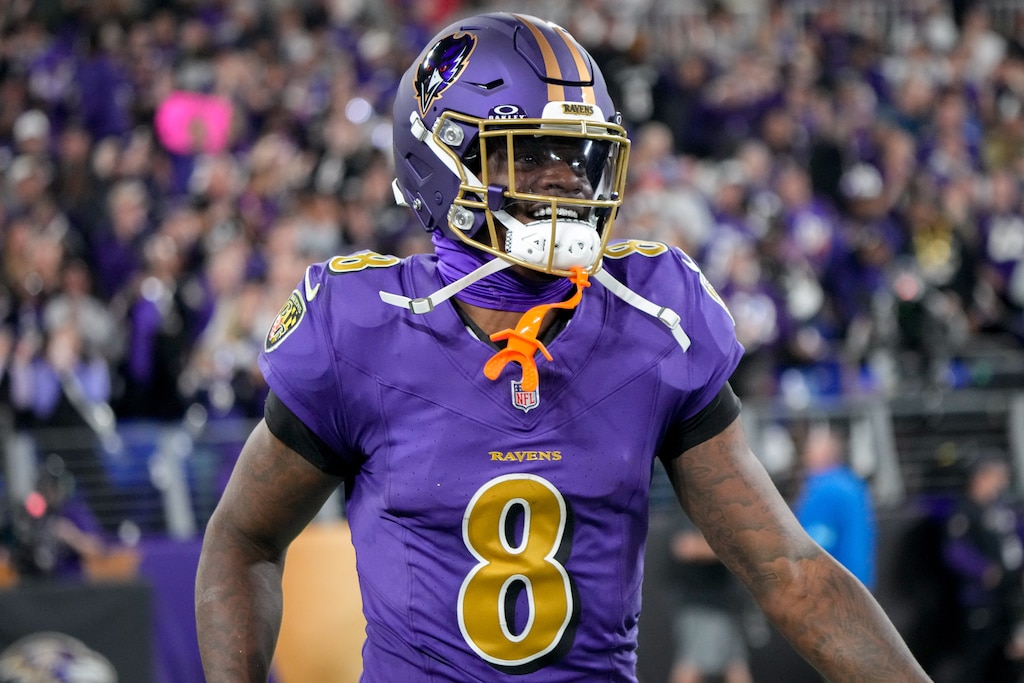The first thing to acknowledge about the NFL’s closely contested Most Valuable Player race is its sheer novelty.
Cincinnati Bengals quarterback Joe Burrow could hit 5,000 passing yards Saturday, a mark only nine players have ever reached. Philadelphia Eagles running back Saquon Barkley could set the league’s single-season rushing record Sunday. Ravens quarterback Lamar Jackson was the first player in NFL history to post 3,500 passing yards, 500 rushing yards and fewer than 10 turnovers through 16 games — until Buffalo Bills quarterback Josh Allen matched him a few days later. MVP debates are almost never this competitive because the seasons fueling them almost never happen.
And now time is running out to find tiebreakers. The NFL’s past seven MVPs all played for No. 1 seeds, but Kansas City Chiefs quarterback Patrick Mahomes is a long shot this year. So are the Detroit Lions’ Jared Goff and Minnesota Vikings’ Sam Darnold, who’ll fight for the NFC’s top spot on Sunday night. Allen’s Bills beat both the Chiefs and the Lions, but lost handily in Baltimore to Jackson’s Ravens, who lost handily in Baltimore to Barkley’s Eagles. Burrow’s Bengals might not even make the playoffs.
So who’s going to win MVP honors? With a week left in the regular season, Allen’s the slight betting favorite. As for who should win MVP honors? That’s a different story.
The Baltimore Banner thanks its sponsors. Become one.
“He’ll always be my MVP, I promise you that,” Ravens coach John Harbaugh said Monday of Jackson, already a two-time winner. “As far as I’m concerned, he’s our MVP.”
As Jackson’s best-ever regular season winds down with Saturday’s game against the Cleveland Browns, here are five reasons the NFL’s reigning MVP deserves to repeat.

1. Last year’s voting process shouldn’t matter
One of the most repeated arguments against Jackson’s candidacy is that he was a historical outlier last year, and that some of the same illogic should apply to the 2024 race. The Ravens had the NFL’s No. 4 offense, according to FTN’s efficiency metrics, but Jackson finished outside the top 10 in both touchdown passes (24, 11th) and passing yards (3,678, 15th). No MVP-winning quarterback had ever managed that.
This year, however, promises a return to normalcy. Jackson, like Allen, has fared far better in both counting stats and advanced stats. He’s fifth in passing yards (3,955) and third in passing touchdowns (39), plus second in rushing yards (852) among quarterbacks. Jackson’s also second among starting QBs in expected points added per play (0.29), according to TruMedia, a measure of how well the offense has performed relative to expectations on plays involving him. Jackson is just behind Goff (0.30) and just ahead of Allen (0.27).
That’s a good place to be, because the league’s EPA kings tend to be named MVPs:
The Baltimore Banner thanks its sponsors. Become one.
- 2018: Mahomes (first in the NFL in EPA per play)
- 2019: Jackson (first)
- 2020: Aaron Rodgers (first)
- 2021: Rodgers (first)
- 2022: Mahomes (1st)
- 2023: Jackson (13th)

2. Strength of schedule matters
Maybe the most impressive part of Jackson’s and Allen’s seasons is how they’ve fared against the top defenses on their schedule. The Ravens have played eight games against teams ranked among the top 16 in defensive efficiency, according to FTN. The Bills have played nine such games. Jackson and Allen’s stat lines haven’t looked too different.
- Jackson: 5-3 record, 0.25 EPA per play, 0.20 EPA per drop-back, 19 touchdowns (three rushing), two interceptions, 65.2% accuracy, 266.8 total yards per game
- Allen: 7-2 record, 0.24 EPA per play, 0.19 EPA per drop-back, 15 touchdowns (four rushing, one receiving), three interceptions, 62.2% accuracy, 257.9 total yards per game
Narrow it to upper-quartile defenses — units ranked among the top eight — and Jackson starts to distance himself. (The samples are admittedly small; Jackson has played just four such games, and Allen just three.)
- Jackson: 3-1 record, 0.45 EPA per play, 0.40 EPA per drop-back, 11 touchdowns (two rushing), no interceptions, 70.5% accuracy, 266.3 total yards per game
- Allen: 1-2 record, 0.12 EPA per play, 0.07 EPA per drop-back, five total touchdowns (two rushing), no interceptions, 51.6% accuracy, 272 total yards per game
Still, for as important as late-season pushes might be to the MVP race — just look at Jackson last year — the award is nominally about a player’s whole body of work. And if Jackson and Allen are relative equals statistically, then their schedules should factor into the calculus, too.
That’s where Jackson has a clear advantage. The Ravens’ offense has faced the NFL’s fourth-hardest slate of defenses this season, according to FTN. Buffalo? Just 21st. Among the defensive pushovers on the Bills’ schedule: the Jacksonville Jaguars (32nd in efficiency), the New England Patriots (30th) and the New York Jets (27th) — twice.

3. Allen’s bad games weren’t always punished
Not all losses are created equally. Just look at how the Ravens and Buffalo have fared when their leading men have underwhelmed.
The Baltimore Banner thanks its sponsors. Become one.
The Ravens are 11-0 when Jackson has averaged over 0.12 EPA per play this season and 0-5 when he’s averaged 0.12 EPA or worse. Considering Jackson had three average-to-solid performances in that sample, the Ravens should’ve won at least one of those games, if not two. Here’s how those losses have broken down, according to TruMedia:
- Week 1 vs. Chiefs (27-20 loss): 0.01 EPA per play
- Week 2 vs. Raiders (26-23 loss): minus-0.04 EPA per play
- Week 8 vs. Browns (29-24 loss): 0.12 EPA per play
- Week 11 vs. Steelers (18-16 loss): minus-0.24 EPA per play
- Week 13 vs. Eagles (24-19 loss): 0.05 EPA per play
The Bills, meanwhile, are 12-0 when Allen has averaged over 0.12 EPA per play and 2-2 when he’s averaged 0.12 EPA or worse. Even more impressive, one of those wins came in a game when he finished with negative EPA. Here’s how those games have broken down:
- Week 4 vs. Ravens (35-10 loss): minus-0.23 EPA per play
- Week 5 vs. Texans (23-20 loss): minus-0.08 EPA per play
- Week 10 vs. Colts (30-20 win): minus-0.07 EPA per play
- Week 16 vs. Patriots (24-21 win): 0.05 EPA per play
For so long this season, Jackson’s barriers to victory were higher than almost any quarterback’s in the league. The Ravens’ defense was one of the NFL’s worst through Week 10. Their special teams play unraveled in high-leverage spots. Even on offense, Jackson had to watch as penalties on teammates undercut drives.
The Bills’ superior record is ostensibly a mark in Allen’s favor. But it ignores the support Jackson received — or didn’t — earlier in the season.

4. Both QBs have good supporting casts
The most compelling argument in Allen’s favor has to do with his surroundings — and Jackson’s, too. Buffalo’s offense lost wide receiver Stefon Diggs in the offseason and somehow got better. The Ravens’ offense added running back Derrick Henry and obviously got better.
The Baltimore Banner thanks its sponsors. Become one.
But has Allen really meant more to the Bills’ success than Jackson has to the Ravens’? Let’s break it down, unit by unit.
Blocking: As of last week, Buffalo had Pro Football Focus’ third-rated offensive line, and this week ranks fifth and 14th, respectively, in ESPN’s pass block and run block win rates. According to Sports Info Solutions, all five Bills starting linemen have a blown-block rate between 1.9% and 2.6%.
The Ravens, meanwhile, had PFF’s No. 7 line and rank third on ESPN in both pass block and run block win rates. According to SIS, however, the Ravens’ starters have been more error-prone, with three of their five regulars within the Bills’ blown-block range, and left tackle Ronnie Stanley (3.4%) and right tackle Roger Rosengarten (4.6%) checking in above it.
As pocket passers, Allen and Jackson are uniquely gifted — athletic enough to not only affect how defenses attack the pocket and defend the run, but also to routinely turn would-be sacks into positive plays. According to PFF, just 8% of Allen’s pressures have resulted in a sack, the NFL’s best mark. Jackson is not far behind, ranking third among regular starters (12.2%).
Receiving: Jackson benefits more than Allen does from his receivers’ ability to separate. That’s indisputable. (In the Fantasy Points chart below, “ASS” stands for Average Separation Score, a proprietary metric; “ANY/A” for adjusted net yards per attempt, a more common statistic that accounts for passing yardage, sacks, touchdowns and interceptions.)
The Baltimore Banner thanks its sponsors. Become one.
But Jackson has not built his MVP case on throws to wide-open receivers. And Allen has not built his MVP case on tight-window throws. Their splits are, in fact, closer than you’d imagine. On attempts at least 5 yards downfield, here’s how their passing production breaks down, as measured by their target’s separation from the nearest defender in coverage, according to the NFL’s Next Gen Stats:
- Tight window (less than 1 yard of separation): Jackson is 14-for-38 (36.8%) for 295 yards (7.8 yards per attempt), six touchdowns and no interceptions, with a 104.7 passer rating. Allen is 21-for-69 (30.4%) for 428 yards (6.2 yards per attempt), three touchdowns and one interception, with a 61.7 passer rating.
- Neutral (1 to 3 yards of separation): Jackson is 54-for-97 (55.7%) for 953 yards (9.8 yards per attempt), 11 touchdowns and one interception, with a 122.9 passer rating. Allen is 53-for-100 (53%) for 851 yards, eight touchdowns and two interceptions, with a 100.0 passer rating.
- Open (at least 3 yards of separation): Jackson is 92-for-116 (79.3%) for 1,580 yards (13.6 yards per attempt), 12 touchdowns and one interception, with a 149.6 passer rating. Allen is 64-for-82 (78%) for 1,140 yards, three touchdowns and no interceptions, with a 130.9 passer rating.
Rushing: Henry is second in the league in rushing yards (1,783) and, in any other year, would be a top contender for the NFL Offensive Player of the Year Award. But Jackson was already the NFL’s most feared rushing quarterback. Henry’s arrival in Baltimore has not dramatically changed how teams defend the Ravens’ running game.
According to TruMedia, the Ravens are third in the NFL in the percentage of runs against boxes with at least eight defenders (27%); the Bills are second (27.7%). Henry is second in the league in overall rushing efficiency, according to FTN; Buffalo running back James Cook is third. The Ravens and Bills have two of the NFL’s best rushing attacks, but the biggest force multiplier on each is their quarterback.

5. Historic seasons should be rewarded
Allen’s season has been transformative, lifting the Bills to a pair of wins more impressive than any other team’s this season. But his year has not quite been historic. Jackson’s has.
Start with the Ravens’ overall success. They rank first in the NFL in adjusted efficiency, according to FTN — No. 1 in passing and rushing — and their offense’s performance through 16 games rivals that of any team in league history. Only one team since 2000 has averaged more yards per play than these Ravens (6.9): the 2000 St. Louis Rams, who averaged 7.0 during their “Greatest Show on Turf” heyday.
The Baltimore Banner thanks its sponsors. Become one.
Then there’s Jackson. Along with the NFL’s all-time rushing record for a quarterback, which he set in Week 17, here is a far-from-comprehensive list of statistics in which Jackson ranks No. 1 entering Week 18:
- QBR
- Passer rating
- EPA per drop-back
- Yards per pass attempt
- Touchdown rate
- Touchdown-to-interception ratio
- Explosive-pass-play rate (gains of at least 16 yards)
- Yards per carry
Jackson has said he does not care whether he’s named MVP, but that shouldn’t diminish his candidacy. Nor should the fact that Jackson’s already won two, or that Allen has yet to win one himself. Each season should stand on its own merits, and Jackson’s are exceptional. The only thing his 2024 lacks is the one thing that eluded him in 2019, and in 2023, and every other year his Ravens have needed more: a Super Bowl title. If Jackson’s season ends in February amid a wave of confetti, this year’s MVP voting will remain an afterthought.
“I always want to finish with the championship, but I’ve been falling short,” Jackson said last week. “Got that accolade, but I still feel like the MVP is a team thing, though, because my teammates [are] helping me get that award, because I always say that I’m not the one catching the passes, blocking to help me get these passes off, stuff like that. That’s offensive line, tight ends, receivers, running backs. It’s everybody, all of us included.
“I’m trying to win the championship. That’s my biggest goal. That’s been my goal ever since [I was] a little kid, but an MVP in the National Football League — that’s dope. That is dope.”




Comments
Welcome to The Banner's subscriber-only commenting community. Please review our community guidelines.